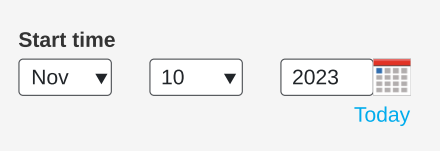Whether you're planning a special occasion, tracking project deadlines, managing schedules, or simply curious about time differences in different time zones, our Time Calculator is your one-stop solution for effortless time calculations.
Here is a step-by-step guide on how to use our tools to add or subtract time and add or subtract time from a date.
1. Enter the values for Days, Hours, Minutes, and Seconds in the respective fields.

Note: The input values must be integers equal to or higher than 0.
2. Select “+Add” or “-Subtract”.

3. Press the “Calculate” button. The results will be displayed on your screen within less than a second.

4. If you want to calculate other time values, press the “Clear” button and repeat the above steps.
1. Input the Start Time information in the respective fields.
Tap or click the drop-down arrow, and select the Month and Day. Next, type in the value for the Year.

Quick tip: Tap the “Today” option to automatically select today as the Start Time.
Enter the values for hours, minutes, and seconds (HMS) in the respective fields. Note that the values you input must be integers equal to or higher than 0.

Quick tips: Tap or click the “Now” option to auto-fill current time values for H-M-S. If you choose the “Start a day” option, the values for H-M-S will be 12:00:00 AM. If you choose the “Noon” option, the values for H-M-S will be 12:00:00 PM.
2. Select “+Add” or “-Subtract”.

3. Input the time duration you want to add to or subtract from the “Start Time” by entering the values for Years, Months, Weeks, Days, Hours, Minutes, and Seconds in the respective fields.

Note: The values you enter must be integers equal to or higher than 0.
4. Press the “Calculate” button to see the results.

5. Press the “Clear” button and repeat the above steps to calculate other time values.
Time calculators, without a doubt, are simple yet super powerful tools for time management, effectively assisting you in tons of time-related tasks and calculations. The tools are easy to use and beneficial for various different groups of people in both personal and professional contexts.
5 highlighted features:
In fact, Time Calculators can be valuable tools for various individuals and professionals who deal with time-related tasks and calculations.
4 groups of people who can benefit from using a time calculator:
Lots of people find themselves struggling with calculating time manually, especially when time length calculation or adding and subtracting time involves complex calculations with multiple time units, different time zones, or date formats. Here are 03 common challenges people face when manually calculating time:
In a nutshell, manual time calculations pose serious challenges and difficulties when it comes to quickly and correctly subtracting or adding times together. An online time calculator, on the other hand, is more than just a modern convenience. It's a solution for dealing with the complexities of time management—it eliminates the risk of human error, allows users to effortlessly calculate time, helps save time, etc.
American and European timekeeping systems differ in their clock formats and time zone management. The United States primarily employs a 12-hour clock, dividing the day into two AM and PM periods, while most European countries utilize a 24-hour clock, expressing time in a continuous format from 00:00 to 23:59.
For example, in the US, 09:00 AM means 9 o'clock in the morning, and 09:00 PM means 9 o'clock in the evening, but in Europe, 09:00 means 09 o'clock in the morning, and 21:00 means 09 o'clock in the evening.
Additionally, the United States has four main time zones, while Europe has a more complex network of time zones due to its geographical diversity. Understanding these differences is crucial for travelers and business professionals navigating between the two regions.
Time units are the standard means of measuring and expressing time intervals. Here are the seven most commonly used time units, of which the second is the base unit:
Time units | Equals | Equals to seconds |
Second (s) | Base Unit | |
Minute (min) | 01 minute = 60 seconds | 60s |
Hour (hr) | 01 hour = 60 mins | 3,600s |
Day (d) | 01 day = 24 hrs 01 day = 1,440 mins | 86,400s |
Week (wk) | 01 week = 7 days 01 week = 168 hrs 01 week = 10,080 mins | 604,800s |
Month (mo) | 01 month has from 28 to 31 days 01 month ~ 4 weeks | From 2,419,200s to 2,678,400 |
Year (y) | 1 year has 365 or 366 days 1 year ~ 52 weeks | ~31,557,600 seconds |
Common Units of Time
Following is a table of the number of hours in some common time periods:
Time Period | Number of Hours |
01 Second | 0.00027777777 hours |
01 Minute | 0.01666666666 hours |
01 Hour | 1 hour |
01 Day | 24 hours |
01 Week | 168 hours |
01 Month | From 672 hours to 744 hours |
01 Year | 8,760 or 8,784 hours |
01 Decade | It depends |
Numbers of Hours (Hrs) in common time periods
By using online and automated time calculators, you can easily add and subtract date and time duration; no worries about potential human risks while saving time and boosting productivity, efficiency, accuracy, and creativity in your personal and professional lives.